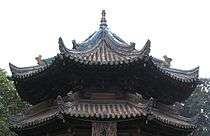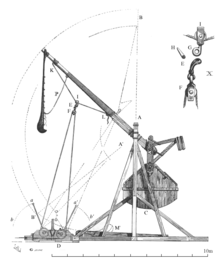Islam during the Yuan dynasty
| Part of a series on:
Islam in China | ||||||
|---|---|---|---|---|---|---|
 | ||||||
|
||||||
|
| ||||||
The establishment of the Yuan dynasty in China in the 13th century dramatically increased the number of Muslims in China. Foreigners in China were given an elevated status in the hierarchy of the new regime. The impact on China by its Muslims at this time, including the advancement of Chinese science and the designing of Dadu, is vast and largely unknown. It is estimated that in the 14th century, the total population of Muslims in China was 4,000,000.[1]
History
Elevated status
Though the Yuan dynasty, unlike the western khanates, never converted to Islam, the Mongol rulers of the dynasty elevated the status of foreigners of all religions from west Asia like Muslims, Jews, and Christians versus the Han, Khitan, and Jurchen, and placed many foreigners such as Muslim Persians and Arabs, Jews, Nestorian Christians, Tibetan Buddhist Lamas, and Buddhist Turpan Uyghurs from Central and West Asia in high-ranking posts instead of native Confucian scholars. The state encouraged Muslim immigration, as Arab, Persian and Turkic immigration into China accelerated during this period. The Mongol emperors brought hundreds of thousands of Muslims with them from Persia to help administer the country. Many worked in the elite circles arriving as provincial governors. They were referred to as Semu.
The territory of the Yuan was administered in 12 districts during the reign of Kublai Khan with a governor and vice-governor each. According to Iranian historian Rashid-al-Din Hamadani, of these 12 governors, 8 were Muslims; in the remaining districts, Muslims were vice-governors.[2]
Over 10,000 Muslim names can be identified in Yuan historical records. The standard word used to denote Muslims in Chinese language documents of the late Yuan period is "Huihui". The Muslims were overseen by a Huihui named Yeheidie'erding (Amir al-Din) who designed Qionghua island which sits in the lake of Beihai Park in central Beijing.[3] In the fourteenth century, the total population of Muslims in China was 4,000,000.[1]
At the same time the Mongols imported Central Asian Muslims to serve as administrators in China, the Mongols also sent Han Chinese and Khitans from China to serve as administrators over the Muslim population in Bukhara in Central Asia, using foreigners to curtail the power of the local peoples of both lands.[4]
New communities
The Yuan dynasty saw the formation of Muslim communities in North China and Yunnan. The descendants of these communities who were to merge completely with the local Han Chinese, nevertheless sought down to our own day to preserve their own personality and were to show a marked tendency to autonomy.[5]
Yuan oppression of Muslims
Genghis Khan and the following Yuan Emperors forbade Islamic practices like Halal butchering, forcing Mongol methods of butchering animals on Muslims, and other restrictive degrees continued. Muslims had to slaughter sheep in secret.[6] Genghis Khan directly called Muslims and Jews "slaves", and demanded that they follow the Mongol method of eating rather than the halal method. Circumcision was also forbidden. Jews were also affected, and forbidden by the Mongols to eat Kosher.[7] Toward the end, corruption and the persecution became so severe that Muslim Generals joined Han Chinese in rebelling against the Mongols. The Ming founder Zhu Yuanzhang had Muslim Generals like Lan Yu who rebelled against the Mongols and defeated them in combat. Some Muslim communities had the name in Chinese which meant "baracks" and also mean "thanks", many Hui Muslims claim it is because that they played an important role in overthrowing the Mongols and it was named in thanks by the Han Chinese for assisting them.[8]
Among all the [subject] alien peoples only the Hui-hui say “we do not eat Mongol food”. [Cinggis Qa’an replied:] “By the aid of heaven we have pacified you; you are our slaves. Yet you do not eat our food or drink. How can this be right?” He thereupon made them eat. “If you slaughter sheep, you will be considered guilty of a crime.” He issued a regulation to that effect ... [In 1279/1280 under Qubilai] all the Muslims say: “if someone else slaughters [the animal] we do not eat”. Because the poor people are upset by this, from now on, Musuluman [Muslim] Huihui and Zhuhu [Jewish] Huihui, no matter who kills [the animal] will eat [it] and must cease slaughtering sheep themselves, and cease the rite of circumcision.
The Muslims in the semu class also revolted against the Yuan dynasty in the Ispah Rebellion but the rebellion was crushed and the Muslims were massacred by the Yuan loyalist commander Chen Youding.
During the Ming conquest of Yunnan, Muslim generals Mu Ying and Lan Yu led Muslim troops loyal to the Ming dynasty against Mongol and Muslim troops loyal to the Yuan dynasty.[10][11]
Muslim influence
Science
Muslim scientists were brought to work on calendar making and astronomy. Kublai Khan brought Iranians to Beijing to construct an observatory and an institution for astronomical studies.[12] Jamal ad-Din, a Persian astronomer, presented Kublai Khan with seven Persian astronomical instruments.[13] The work of Islamic geographers also reached China during the Yuan dynasty and was later used in the Ming dynasty to draw the Western Regions in the Da Ming Hun Yi Tu, the oldest surviving world map from East Asia.
Muslim doctors and Arabic medical texts, particularly in anatomy, pharmacology, and ophthalmology, circulated in China during this time. The Chinese emperor, Kublai Khan, who suffered from alcoholism and gout, accorded high status to doctors. New seeds and formulas from the Middle East stimulated medical practice. The traditional Chinese study of herbs, drugs, and portions came in for renewed interest and publication.[12] One of the medical texts introduced from the Islamic world included Avicenna's The Canon of Medicine, much of which was translated into Chinese as the Hui Hui Yao Fang (Prescriptions of the Hui Nationality) by the Hui people in Yuan China.[14]
Warfare
The Mongols eagerly adopted new artillery and technologies. Kublai brought siege engineers, Ismail and Al al-Din, together they invented the "Muslim trebuchet" (Hui-Hui Pao), which was utilized by Kublai Khan during the Battle of Xiangyang.[15]
Economy
The Mongols used Persian, Arab and Buddhist Uyghur administrators to act as officers of taxation and finance. Muslims headed most corporations in China in the early Yuan period but as the Chinese bought shares, most corporations acquired mixed membership, or even complete Chinese ownership.[12]
It was during the Yuan dynasty that the port of Quanzhou flourished. Led by the Chinese Muslim tycoon Pu Shougeng they submitted to the Mongol advance. This was in stark contrast to the port of Guangzhou that was sacked. Quanzhou was made famous on account of the accounts of the famous travelers Ibn Battuta and Marco Polo who visited the port. Today a large number of stone inscriptions can be seen at Quanzhou, such as 300 stone inscriptions on tombs, graves and mosques.
Designing Dadu
The Muslim architect Yeheidie'erding (Amir al-Din) learned from Han architecture and designed and led the construction of the capital of the Yuan dynasty, Dadu (or known as Khanbaliq or Khanbaligh to the Turks).[16] The construction of the walls of the city began in 1264, while the imperial palace was built from 1274 onwards. The design of Dadu followed the Confucianism classic Zhouli (周禮, "rites of Zhou"), in that the rules of “9 vertical axis, 9 horizontal axis”, “palaces in the front, markets in the rear”, “left ancestral worship, right god worship” were taken into consideration. It was broad in scale, strict in planning and execution, complete in equipment.[17] Dadu officially became the capital of the newly established the Yuan dynasty in the 1270s, though some constructions in the city were not completed until 1293. It would last until 1368 when Zhu Yuanzhang, the founder of the Ming dynasty and future Hongwu Emperor, made his imperial ambitions known by sending an army toward the Yuan capital.[18] The last Yuan emperor fled north to Shangdu and Zhu declared the founding of the Ming after razing the Yuan palaces in Dadu to the ground,[18] and the city was renamed to Beiping by the Ming in the same year.
Other events
Marco Polo also met Nasaruddin who was the son of the conqueror and governor of Yunnan Sayid Ajjal of Bokhara, as appointed by the Mongols.
Arabic storytellers at the time were narrating fantastical stories of China, which were incorporated into the One Thousand and One Nights (Arabian Nights), the most famous being the story of Aladdin. Other Arabian Nights tales set in China include "Tale of Qamar al-Zaman and Budur", "The Story of Prince Sayf al-Muluk", and the "The Hunchback's Tale" story cycle.[19]
In the mid 14th century, the Ispah Rebellion led by Chinese Persian Muslims broke out in South Fujian. After the rebellion was suppressed the local Han Chinese in Quanzhou turned against Semu people and great misery was brought upon the Muslim population. Quanzhou itself ceased to be a leading international seaport.
See also
Notes
- 1 2 Israeli (2002), p. 285
- ↑ Islam the Straight Path: Islam ... - Google Book Search at books.google.co.uk
- ↑ Yang Huaizhong, "Yeheidie'erding" (Amir al-Din) in Bai Shouyi, Zhongguo Huihui minzu shi, op. cit., pp.813-818.
- ↑ Buell, Paul D. (1979). "Sino-Khitan administration in Mongol Bukhara". Journal of Asian History. Harrassowitz Verlag. pp. 137–8. JSTOR 41930343.
- ↑ Gernet, Jacques. A History of Chinese Civilization. 2. New York: Cambridge University Press, 1996. ISBN 0-521-49712-4
- ↑ Michael Dillon (1999). China's Muslim Hui community: migration, settlement and sects. Richmond: Curzon Press. p. 24. ISBN 0-7007-1026-4. Retrieved 2010-06-28.
- ↑ Johan Elverskog (2010). Buddhism and Islam on the Silk Road (illustrated ed.). University of Pennsylvania Press. p. 228. ISBN 0-8122-4237-8. Retrieved 2010-06-28.
- ↑ Dru C. Gladney (1991). Muslim Chinese: ethnic nationalism in the People's Republic (2, illustrated, reprint ed.). Council on East Asian Studies, Harvard University. p. 234. ISBN 0-674-59495-9. Retrieved 2010-06-28.
- ↑ Donald Daniel Leslie (1998). "The Integration of Religious Minorities in China: The Case of Chinese Muslims" (PDF). The Fifty-ninth George Ernest Morrison Lecture in Ethnology. p. 12. Retrieved 30 November 2010..
- ↑ Tan Ta Sen, Dasheng Chen (2009). Cheng Ho and Islam in Southeast Asia. Institute of Southeast Asian Studies. p. 170. ISBN 981-230-837-7. Retrieved 2010-06-28.
- ↑ Michael Dillon (1999). China's Muslim Hui community: migration, settlement and sects. Richmond: Curzon Press. p. 34. ISBN 0-7007-1026-4. Retrieved 2010-06-28.
- 1 2 3 Richard Bulliet, Pamela Crossley, Daniel Headrick, Steven Hirsch, Lyman Johnson, and David Northrup. The Earth and Its Peoples. 3. Boston: Houghton Mifflin Company, 2005. ISBN 0-618-42770-8
- ↑ Zhu (1946)
- ↑ Jan Van Alphen, Anthony Aris, Fernand Meyer, Mark De Fraeye (1995). Oriental Medicine. Serindia Publications. p. 201. ISBN 0-906026-36-9.
- ↑ C. P. Atwood Encyclopedia of Mongolia and the Mongol Empire, p.354
- ↑ People's Daily Online: The Hui ethnic minority
- ↑ 《明史纪事本末》、《纲鉴易知录》卷八
- 1 2 Ebrey, Patricia Buckley. The Cambridge Illustrated History of China. Cambridge: Cambridge University Press, 1999. ISBN 0-521-66991-X
- ↑ Ulrich Marzolph, Richard van Leeuwen, Hassan Wassouf (2004). The Arabian Nights Encyclopedia. ABC-CLIO. pp. 521–2. ISBN 1-57607-204-5.

